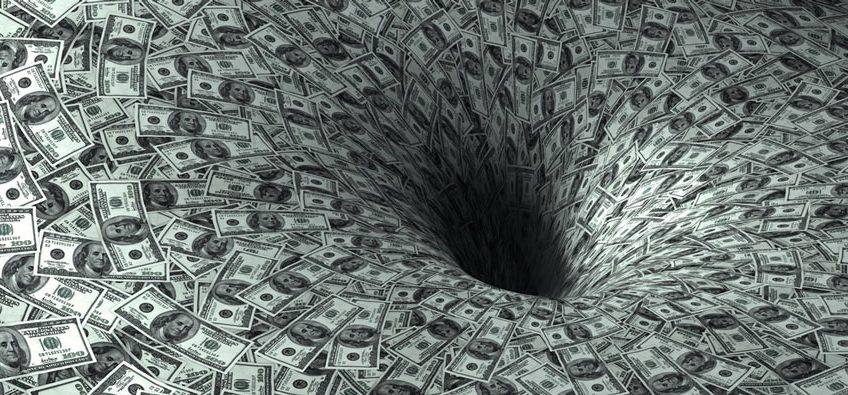
Is the U.S. Approaching Its Worst Debt Crisis In History?

The U.S. is on the Brink of a Major Debt Crisis

With a $20 trillion national debt, it sure appears the U.S. is approaching a debt crisis. This past week President Trump addressed Congress with a pro-jobs and growth message that prompted a stock market rally the next day. As a result, gold saw some push back.
However despite this optimism, there are some longer term aspects of the President’s fiscal policy that will probably be deleterious long term. Notably, that this administration will significantly add to the national debt with increased spending as well as tax cuts.
When President Trump took office, there was $382 billion cash in the treasury. It’s now at $178 billion. In In addition, the U.S. is fast approaching its debt ceiling. In 2015, Congress and President Obama suspended it until March 15, 2017. The debt ceiling is set at $20 trillion, so the only solution will likely be to raise the ceiling again. However this is probably going to turn into a heavily politicized vote with both parties becoming even more bipartisan. Consequently, delay in reaching a budget and debt ceiling decision could lead to another government shut down.
What this means for investors: Sovereign debt crises can lead to financial collapse and volatility. Furthermore, inability or delay to reach a debt ceiling solution will lead to safe haven demand for gold picking up. Watch below as David Stockman (President Reagan’s budget chief) discusses what he is reading for an approaching debt crisis.
David Stockman, Budget Chief to Ronald Reagan, on Debt Crisis – Watch Here
Trouble Seeing Video? You can also click here to watch
“There is going to be a debt ceiling crisis like never before this summer, and that’s what people don’t realize” – David Stockman on Fox Business Network with Neil Cavuto
5 Notable Debt Crises in Modern History

1.) 1980s Latin America
In the 1970s, the governments of Mexico, Brazil, and Argentina had borrowed heavily to fund industrialization. By the 80s, the region was over 50% debt to GDP and couldn’t pay back loans. The 300% rise in oil prices certainly worsened the crisis. Growth slowed, and currencies depreciated.
2.) 2008 – 2009 Europe
The collapse of financial institutions triggered the European sovereign debt crisis. These collapses are attributed to high levels of government debt and rapidly rising bond yields. The crisis started in Iceland and spread rapidly to Greece, Portugal, and Ireland (the hardest hit countries). In addition to these three, Cyprus and Spain were unable to pay off or re-finance their debt without ample assistance from the ECB and IMF. The bailed out countries have been forced to utilize austerity measures while the EU attempts to use quantitative easing to promote some economic growth. Growth is still rather sluggish, and the crisis caused a lack of confidence in governments.
3.) 2013 U.S.
This was more of a debt ceiling crisis rather than debt crisis. As the U.S. approached its debt ceiling, there was fierce debate on whether House Republicans would vote to raise the ceiling. In the past, votes to raise the debt ceiling usually passed without questions. However in 2013, Republicans demanded a reduction in spending in exchange for a vote to lift the ceiling. It led to a sequester and government shut down before the budget was resolved. It brought up the dangers of government over-spending, but it seems many politicians have already forgotten their principles.
4.) 2015 – 2017 Greece
Greece has never really recovered from its sovereign debt crisis. In fact, its outlook is looking dire again. The government cannot pay off its loans from the ECB and IMF. Germany is heavily opposed to bank rolling more loans, but in fact might need to to keep the Eurozone together. The IMF does not want to fund more bail out, and Greece is refusing more austerity cuts. Furthermore, Europe is a highly politically volatile region right now, and this debt crisis will trigger significantly more uncertainty.
5.) 2016 China
China’s debt in 2016 reached more than 250% of GDP. In 2009, China launched a $600 billion economic stimulus that has rather proving to stymie growth now. China missed growth projections for last year, and it seems like it also could his year as well. This would probably trigger a significant financial crash.
Gold Pulls Back this Week, 2-Year Bond Yields Climb
 Gold closed the week with some price pull back. Some of the reasons were a stronger dollar, high chance of an interest rate hike this month, and a solid week for the stock market. The dollar and stock market also got boosts from the President’s address to Congress this week. Silver is more or less tracking gold right now.
Gold closed the week with some price pull back. Some of the reasons were a stronger dollar, high chance of an interest rate hike this month, and a solid week for the stock market. The dollar and stock market also got boosts from the President’s address to Congress this week. Silver is more or less tracking gold right now.
The U.S. dollar was at an 8-week high this week. This was anticipation of a rate hike coming this month. On Friday, Yellen confirmed that the case for a rate hike had strengthened, and that we would possibly see a couple more before the end of the year.
What this means for investors: Some investors used the dip as a prime buying opportunity. Precious metals are following their standard pattern of moving inversely to the dollar. As David Stockman and many other analysts have pointed out though, there is a long-term trend in effect in this market and fiscal plan that will eventually lead to crisis.
Subscribe Now to Get the Gold Market Discussion Delivered Direct to Your Inbox
Here are some articles from the web discussing the topics in this week’s post:
The U.S. is on the Brink of Debt Crisis
Budget Chief David Stockman Video
5 Notable Debt Crises in Modern History
Gold Pulls Back this Week, 2-Year Bond Yields Climb
As always, I encourage you to speak with your broker at RME for more market updates. Expert brokers are available Monday-Friday from 9 AM- 5 PM or by special appointment after hours. Call today at 602-955-6500 or toll-free at 877-354-4040.

